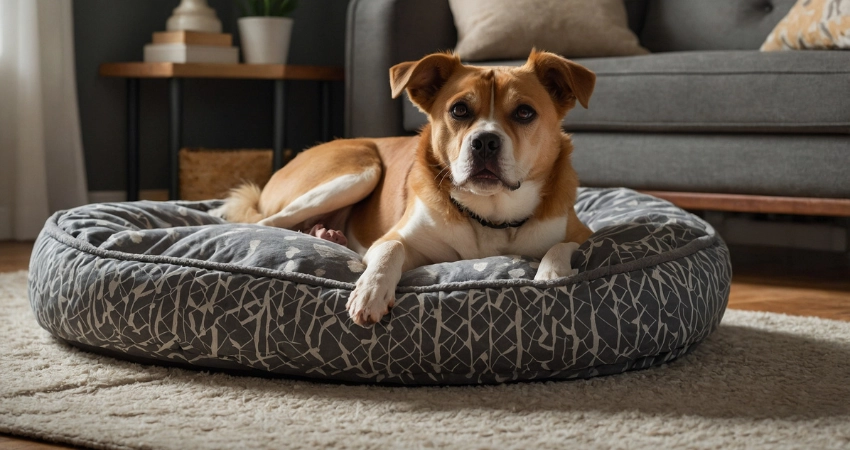Choosing a Dog Bed might seem like a simple task, but it’s much more than just an accessory. This choice has a direct impact on your best friend’s well-being, comfort, and even health. Therefore, understanding your dog’s specific needs is essential to making the right decision.
From size and material to style, every detail matters. After all, the bed will be the place where your dog rests and feels safe. Ignoring important factors can result in discomfort or even long-term health problems.
Want to learn how to choose the ideal dog bed and ensure the best for your dog? Here, we’ll explore the key criteria and tips to make this choice easier. Keep reading and discover how to provide your pet with the maximum comfort!
The Importance of a Good Dog Bed
Offering a good dog bed is not just a luxury. Just like us, dogs need a comfortable place to rest and recharge. Having a space of their own helps reduce stress, promotes quality sleep, and prevents them from choosing inappropriate places to sleep, like the couch or your bed.
Moreover, a suitable bed can also prevent joint problems and improve the dog’s posture. Older dogs, for example, benefit from orthopedic beds that provide extra support for their joints.
For puppies, beds with higher edges provide a sense of security, which is crucial during their first months of life.
Therefore, choosing the right bed is an investment in your dog’s physical and emotional health. It’s not just about comfort, but also about taking care of your furry friend’s overall well-being.
How to Choose the Ideal Size
One of the first things to consider is the size of the dog bed. It should be proportional to the dog’s size, allowing them to stretch and settle comfortably. A bed that’s too small can cause discomfort, while one that’s too large may not provide the coziness many dogs seek.
To get it right, measure your dog from the tip of the nose to the base of the tail while they are lying down. Add a few extra inches to ensure they have enough space to move comfortably. This tip is especially useful for larger breeds like Golden Retrievers or German Shepherds.
Another important tip is to consider the available space in your home. Make sure the chosen bed fits well in the environment without compromising circulation or the organization of the space.
Types of Dog Beds Available
There’s a wide variety of dog beds, each catering to specific needs. Below, we explore the main types to help you make the right choice:
- Cushioned beds: Ideal for dogs who like to stretch out while sleeping. They are simple, versatile, and available in various sizes;
- Cave-style beds: Perfect for smaller or shyer dogs who prefer a closed, cozy space;
- Orthopedic beds: Recommended for older dogs or those with joint problems. They provide extra support and materials that relieve pressure on the joints;
- Elevated beds: Suitable for warmer regions, as they allow air circulation beneath the bed, keeping the dog cool;
- Beds with high edges: A great option for dogs who enjoy cuddling or resting their head while sleeping.
Each type of bed offers unique benefits, so it’s important to observe your dog’s habits before deciding.
Materials and Durability
The materials used in a dog bed are also crucial. Beds made of washable, durable fabrics are easy to clean and increase the bed’s longevity. More active dogs or those who love chewing need beds made with robust materials, such as reinforced nylon.
Another key point is the filling. Materials like memory foam or hypoallergenic fibers ensure comfort and safety, especially for dogs with allergies or sensitive skin. Make sure the material doesn’t easily collect fur or dirt.
Investing in a high-quality bed is a smart long-term savings strategy. A well-made bed lasts longer and provides superior comfort for your dog.
How to Identify Your Dog’s Preferences
Observing your pet’s behavior can reveal a lot about their preferences. Dogs who like to stretch prefer flat and spacious beds, while those who curl up tend to choose beds with high edges or rounded shapes.
It’s also worth considering the climate. If you live in a cold area, cushioned and warm beds are ideal. For warmer regions, opt for beds made of cool, breathable fabrics.
Another tip is to introduce the bed gradually, allowing the dog to explore and get familiar with it. This helps avoid rejection and ensures they get the most out of their new space.
Where to Position Your Dog’s Bed
Choosing the right spot for your dog bed is just as important as selecting the model. Ideally, place it in a calm area, away from drafts or high-traffic zones.
If your dog likes to be close to the family, place the bed in the living room or a corner of the bedroom. This creates a sense of belonging and security. In homes with more than one dog, make sure each one has their own bed to avoid disputes.
Additionally, keep the bed clean and organized. This not only ensures your dog’s comfort but also helps maintain a more hygienic environment.
Care and Maintenance
Keeping the dog bed clean is essential for your pet’s health. Wash the covers regularly and, if possible, choose models with waterproof or easy-to-clean materials. This helps prevent the buildup of dust mites, bacteria, and unpleasant odors.
Another tip is to inspect the bed periodically to check for signs of wear. If the internal foam is deformed or the fabric is torn, consider replacing the bed. A well-maintained bed provides more comfort and safety.
Adopting a cleaning and maintenance routine extends the life of the bed and ensures a healthier environment for your dog.
The Investment That’s Worth It
Although some people consider dog beds just an accessory, they are much more than that. Choosing the right dog bed is an investment in your pet’s well-being and the peace of your home. When a dog has a comfortable place to rest, they tend to be calmer, healthier, and happier.
Furthermore, a quality bed reduces future costs from frequent replacements or even health issues that might arise from insufficient support for the animal’s body. For example, dogs that sleep on unsuitable surfaces can develop calluses, joint pain, and even skin problems.
Therefore, consider the choice of bed as part of the essential care for your dog. Just like a good diet and regular vet visits, the place where your dog rests is an integral part of the care they deserve.
How to Make a DIY Dog Bed With a Pillow
Now, if you’re a fan of DIY projects, you’ll be happy to know that you can make great dog beds using simple materials. Here’s a step-by-step guide on how to make a dog bed with a pillow:
Materials Needed
- A large pillow (or two, depending on the size of the dog).
- Durable fabric or an old blanket.
- Scissors.
- Sewing kit or fabric glue.
- Measuring tape.
Step-by-Step
- Measure and Choose the Pillow: Start by measuring your dog from the nose to the tail and choose a pillow that fits their size. For larger dogs, use two pillows side by side.
- Prepare the Fabric Cover: Lay the fabric or blanket on the floor and position the pillow in the center. Cut the fabric, leaving a few extra inches on each side for sewing.
- Sew or Glue the Edges: Fold the fabric over the pillow like an envelope. Sew the edges or use fabric glue to seal them, leaving one side open to insert the pillow. Ensure the stitches are secure.
- Insert the Pillow: Place the pillow inside the cover, adjusting it so it fits snugly.
- Finish the Bed: Close the remaining opening with a zipper, Velcro, or some stitches. This makes it easier to remove the pillow for cleaning.
Done! Now you have a practical, comfortable, and personalized dog bed for your dog to rest in style.
Ensure Comfort and Well-being with the Ideal Dog Bed
Choosing the right dog bed is more than just a simple purchase; it’s a gesture of care and affection. By considering your pet’s specific needs, such as size, behavior, and health conditions, you ensure quality rest and promote their overall well-being.
Remember that a good dog bed also contributes to your four-legged companion’s physical and emotional health. This investment directly reflects their quality of life, reducing future problems and offering comfort in all stages of their life.
With the information in this article, you’re ready to make the best decision. Evaluate the options carefully, apply the tips, and provide your dog with the perfect place to rest and recharge!

